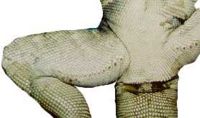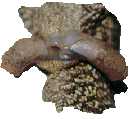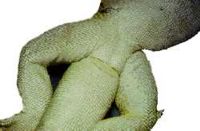Difference between revisions of "Lizard Reproductive System"
(New page: {{unfinished}} [[Image:Male_pores.jpg|200px|thumb|right|'''Male with visible femoral pores''' (© RVC and its licensors, Sean Bobbit, Sue Evans, Andrew Devare and Claire Moore. All rights ...) |
|||
| Line 3: | Line 3: | ||
[[Image:Hemipenes_lizard.jpg|200px|thumb|right|'''Hemipenes - the paired sex organ in male lizards''' (© RVC and its licensors, Sean Bobbit, Sue Evans, Andrew Devare and Claire Moore. All rights reserved)]] | [[Image:Hemipenes_lizard.jpg|200px|thumb|right|'''Hemipenes - the paired sex organ in male lizards''' (© RVC and its licensors, Sean Bobbit, Sue Evans, Andrew Devare and Claire Moore. All rights reserved)]] | ||
[[Image:Female_lizard.jpg|200px|thumb|right|'''Female lizard''' (© RVC and its licensors, Sean Bobbit, Sue Evans, Andrew Devare and Claire Moore. All rights reserved)]] | [[Image:Female_lizard.jpg|200px|thumb|right|'''Female lizard''' (© RVC and its licensors, Sean Bobbit, Sue Evans, Andrew Devare and Claire Moore. All rights reserved)]] | ||
| + | ==Sexing== | ||
| − | + | Male lizards have large femoral pores on the ventral aspect of the thighs; on the other hand, females have small, discrete femoral pores, similar to those of juvenile males. | |
| − | + | '''Male''' | |
Male lizards have paired hemipenes that are sac-like and lack erectile tissue. They are stored, inverted, in the base of the tail and may produce bulges in the ventral proximal tail. Only one is used at a time during copulation and it is not involved in urination. The testicles increase in size during the breeding season. | Male lizards have paired hemipenes that are sac-like and lack erectile tissue. They are stored, inverted, in the base of the tail and may produce bulges in the ventral proximal tail. Only one is used at a time during copulation and it is not involved in urination. The testicles increase in size during the breeding season. | ||
| Line 12: | Line 13: | ||
A row of femoral pores can be seen on the medial aspect of the thigh in many families of lizard. The waxy secretion of cellular debris produced is thought by some to have territorial scent marking significance and by others to prevent the male sliding on the belly of the female during coitus (see also preanal pore). | A row of femoral pores can be seen on the medial aspect of the thigh in many families of lizard. The waxy secretion of cellular debris produced is thought by some to have territorial scent marking significance and by others to prevent the male sliding on the belly of the female during coitus (see also preanal pore). | ||
| − | + | '''Female''' | |
Females have paired ovaries and oviducts. The oviduct is divided into four regions: infundibulum; magnus (secretes albumin); uterus (secretes membrane); and vagina. Dystocia is common and may be pre-ovulatory or post-ovulatory. | Females have paired ovaries and oviducts. The oviduct is divided into four regions: infundibulum; magnus (secretes albumin); uterus (secretes membrane); and vagina. Dystocia is common and may be pre-ovulatory or post-ovulatory. | ||
Revision as of 13:24, 25 February 2010
| This article is still under construction. |
Sexing
Male lizards have large femoral pores on the ventral aspect of the thighs; on the other hand, females have small, discrete femoral pores, similar to those of juvenile males.
Male
Male lizards have paired hemipenes that are sac-like and lack erectile tissue. They are stored, inverted, in the base of the tail and may produce bulges in the ventral proximal tail. Only one is used at a time during copulation and it is not involved in urination. The testicles increase in size during the breeding season.
A row of femoral pores can be seen on the medial aspect of the thigh in many families of lizard. The waxy secretion of cellular debris produced is thought by some to have territorial scent marking significance and by others to prevent the male sliding on the belly of the female during coitus (see also preanal pore).
Female
Females have paired ovaries and oviducts. The oviduct is divided into four regions: infundibulum; magnus (secretes albumin); uterus (secretes membrane); and vagina. Dystocia is common and may be pre-ovulatory or post-ovulatory.


